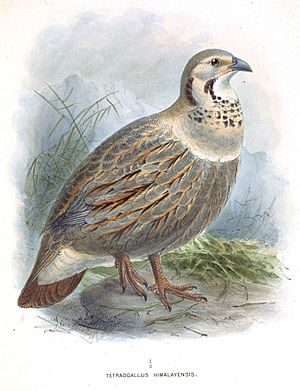The Himalayan snowcock (Tetraogallus himalayensis) is a snowcock in the pheasant family Phasianidae found across the Himalayan ranges and parts of the adjoining Pamir range of Asia. It is found on alpine pastures and on steep rocky cliffs where they will dive down the hill slopes to escape. It overlaps with the slightly smaller Tibetan snowcock in parts of its wide range. The populations from different areas show variations in the colouration and about five subspecies have been designated. They were introduced in the mountains of Nevada in the United States in the 1960s and a wild population has established in the Ruby Mountains.
Description

Illustration by J. G. Keulemans (1891)
The Himalayan Snow-Cock is a large grey partridge-like bird, 55–74 cm (22–29 in) in length and weighing 2–3.1 kg (4.4–6.8 lb). The head pattern has a resemblance to that of the smaller and well marked chukar partridge. The white throat and sides of the head are bordered by chestnut moustachial stripe and a dark broad chestnut band stretching from the eye over the ear, expanding into the collar. The upper parts are grey, with feathers of the rump and the wings are bordered with rufous. The upper breast is grey with dark crescent bars. The lower breast plumage is dark grey, and the sides of the body are streaked with black, chestnut and white. The undertail coverts are white. The legs and orbital skin are yellow. Sexes are alike in plumage, but the female is smaller and lacks the large tarsal spur of the male. In flight, from above, the white primaries tipped in black and the rufous outer tail feathers make it distinctive. The Tibetan snowcock has a wing pattern with white trailing edge to the secondaries that contrasts with the grey wings.
Images for kids
-
Egg, Collection Museum Wiesbaden
See also
 In Spanish: Perdigallo himalayo para niños
In Spanish: Perdigallo himalayo para niños
 In Spanish: Perdigallo himalayo para niños
In Spanish: Perdigallo himalayo para niños







